Often covered by clouds, perched on the top of the namesake mountain approximately 750 m above sea level, Erice is a wonderful village with an ancient history that gives spectacular views and a magical atmosphere, where nature and humans have been able to preserve a divine peace for centuries - it's no coincidence that the ancient Eryx is also known as the Venus town.
Like many other Sicilian towns, the history of Erice is characterized by the passage of numerous peoples and civilizations who have left important cultural imprints and architectural proofs on the territory. So get ready for a memorable trip to Sicily, we have chosen for you 5 iconic and unmissable places to discover in Erice!

Erice: where it is and how to get there
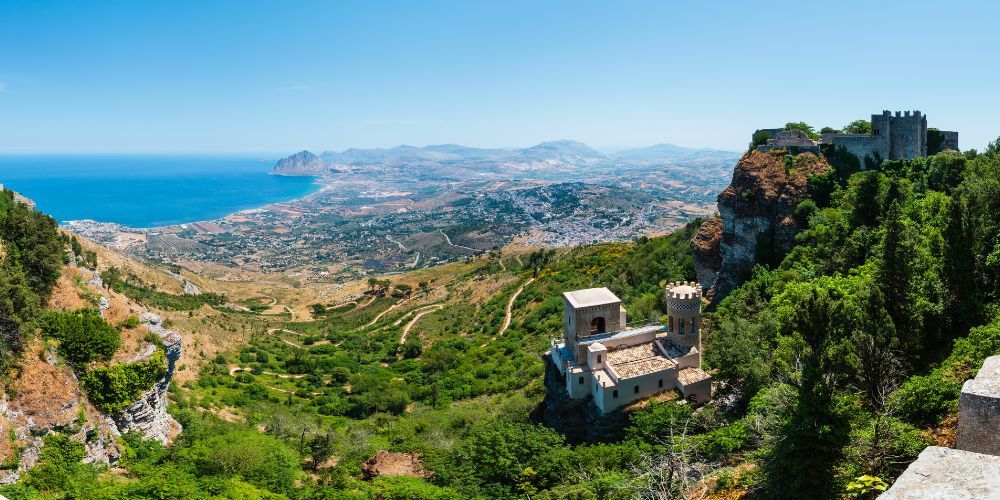
Known as one of the most beautiful villages in Sicily, Erice is a town located near Trapani, in the westernmost area of the region. Built on the top of the namesake mountain on the remains of ancient Eryx, an important Greek-Roman town and sacred place for the cult of Venus, nowadays this village is one of the most fascinating tourist destinations on the island.
To get to Erice from Trapani you can choose between multiple travel options suited to the needs of every type of traveler:
- by car, in less than 30 minutes you can easily reach your destination driving on the SP31 or Via S. Anna, or by taking the SS187 up to Valderice and then continuing to Erice following the signs for the internal roads;
- by cable car, in about 10 minutes it is possible to reach the peak of the mountain and the village of Erice, traveling suspended in a spectacular landscape over the city, the sea and the Egadi Islands; the Trapani funicular railway station is located in Via Capua, in the eastern area of the city, next to the slopes of the mountain;
- by bicycle, in less than 2 hours it’s possible to cycle uphill following the rural roads close to the SS187 up to Valderice, then continuing from here up to Erice (a suitable route for expert cyclists);
- hiking, for the sportiest tourists, in about 3 hours it is possible to reach the top of Erice directly on foot starting from the city, following the paths that go uphill from Via S. Anna.
Would you prefer to reach Erice starting from Palermo? Well, click the button below to experience an exciting full-day guided trip to discover the wonders of western Sicily, with a comfortable round-trip transport in a luxury minibus and a tasting of Sicilian delicacies!
Find out how to visit Erice starting from PalermoWhat to see in Erice on your next trip to Sicily
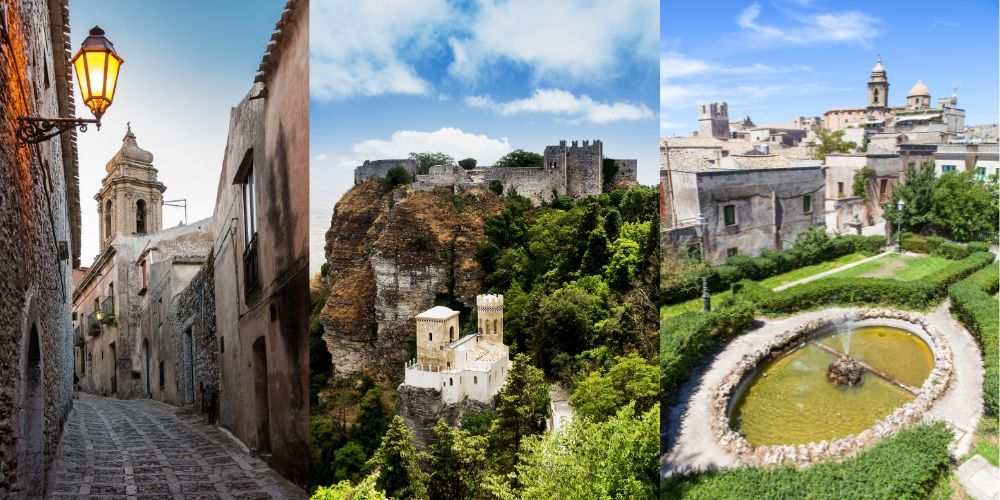
As soon as you get to Erice, crossing the doors of this charming village rich in history perched on one of the most beautiful peaks in Sicily, you immediately understand that your trip here will be an unforgettable experience. Make the most of your trip with us!
Within its thousand-year-old walls, where peoples and civilizations from all over the ancient world crossed their paths, you’ll find colorful cobbled alleys embellished with local handcraft shops, famous above all for the production of ceramics and carpets - refined and valuable souvenirs to buy to remember of this fantastic place!
Explore all of Erice, the ancient city of Venus where stood one of the most important temples dedicated to the Goddess, and discover all its iconic postcard beauties among castles, churches, gardens and the evocative atmosphere given by the breathtaking panoramic view that, from the top of the mountain, it opens onto the city of Trapani and the Egadi Islands, in particular Favignana.
A trip to Sicily cannot be complete without visiting this magical village, hanging between history, culture and authentic flavors: so, let's set off right away to find out together what to see in Erice!
Venus Castle, the Balio Towers and the Gardens
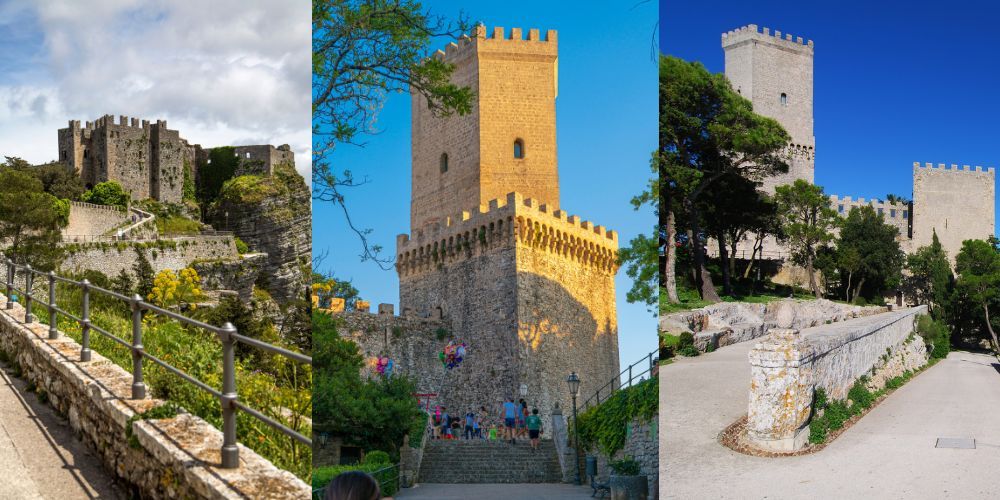
The most iconic and must-see place in Erice is the Venus Castle. This 12th century Norman fortress, a small medieval jewel that stands on an isolated cliff south-east of the peak of Mount Erice, recalls the name of the Goddess as it was built on the ruins of her ancient temple of Venus Ericina.
With the construction of the Castle, were also built fortification walls closely as an advanced defense, where especially the Balio Towers stand out, once directly connected to the castle via a drawbridge which has been replaced by a staircase.
Over time, by now after a millennium, despite the sequence of ages history has not erased the charm of the beauty and power related to this ancient place of worship, which later became a strategic outpost and finally the pearl of Sicilian tourism, brilliantly surviving human events.
With the change of ownership of the castle to Count Agostino Pepoli in 1872, the whole structure was enriched with the introduction of large and elegant English-style public gardens, known as Balio Gardens, in memory of the historic Norman local governor called Baiuolo, Bajulo or Balivo.
Pepoli Tower
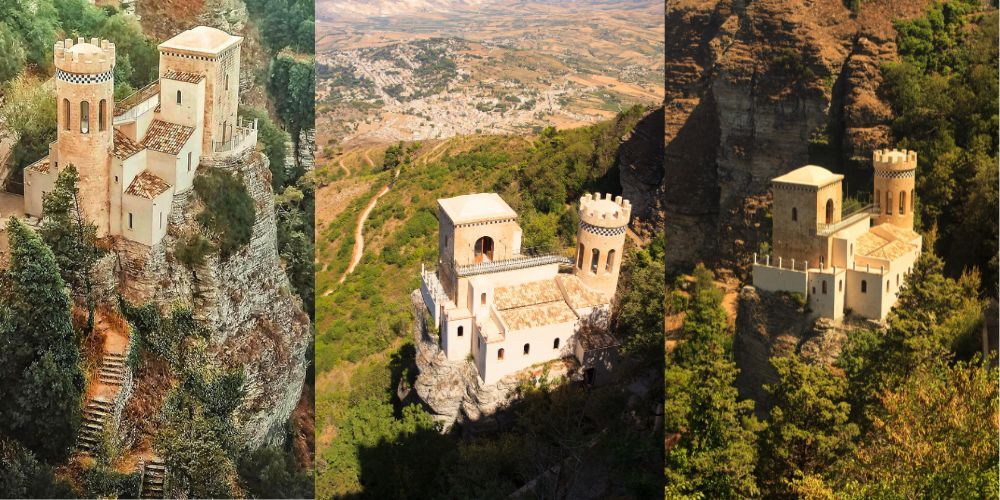
At the same time as the renovation of the castle with the creation of the public gardens, Count Pepoli wanted to make for himself a privileged place where he could find peace, concentration and inspiration for his studies: from this desire the Pepoli Tower was originated, a small tower-shaped house with an appearance similar to a castle in miniature.
Seen from the Balio Gardens, this tower-shaped residence appears completely immersed in the lush vegetation of the pine forest in the surroundings. The Pepoli Tower stands on a rocky peak underneath the castle, and today represents an architectural jewel of public property.
During the years of use of the house by the Count, important men of culture of the time were hosted here, including the scholar Ugo Antonio Amico, the artist Alberto Favara, the archaeologist Antonio Salinas and the minister Nunzio Nasi.
This little tower, which is divided over 4 levels in height, is characterized by a purely Art Nouveau artistic and architectural style, typical of the age of its construction.
After important restoration works that brought the Tower back to its original luxury, today this evocative place is accessible to the public as a true interactive museum recognized by the international community as Observatory of Peace and Lighthouse of the Mediterranean.
The Spanish Quarter
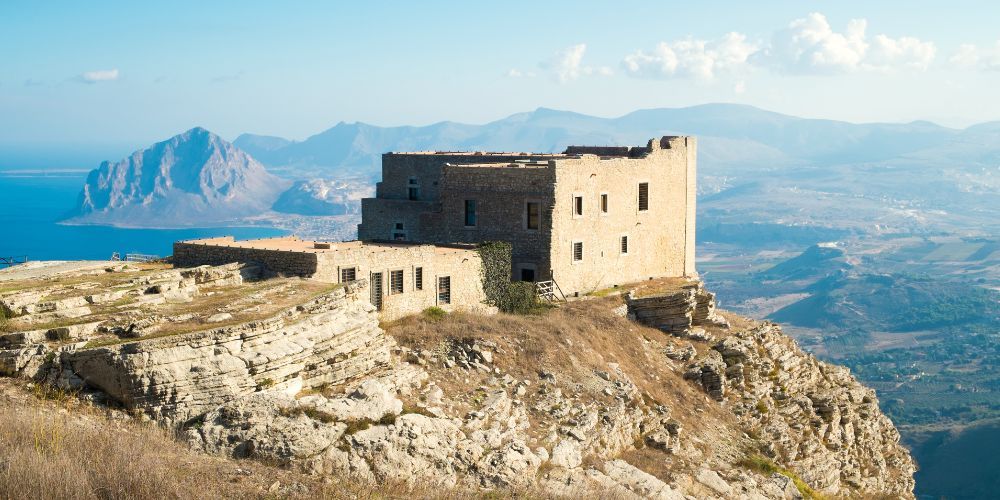
On the opposite side of the castle cliff, on a rocky flat space stands the so-called Spanish Quarter of Erice, an unfinished fortress dating back to the 17th century, a suggestive place for its aesthetics in relation to the surrounding landscape, from which you can enjoy a wonderful view on the Gulf of Bonagia further north.
Originally, this building was designed as a barracks to provide accommodation to the Spanish troops in this corner of Sicily, thanks also to its strategic military position located high up. However, construction work was interrupted and the Quarter remained abandoned for many years.
Today, thanks to important restoration and recovery initiatives for historic buildings, it hosts three exhibitions of the ethnic-anthropological section of the Antonio Cordici Museum of Erice, dedicated respectively to the arts and crafts of the rural world, the tuna fishing and the handcraft production of carpets and ceramics.
The Real Madrice and Cathedral of Erice
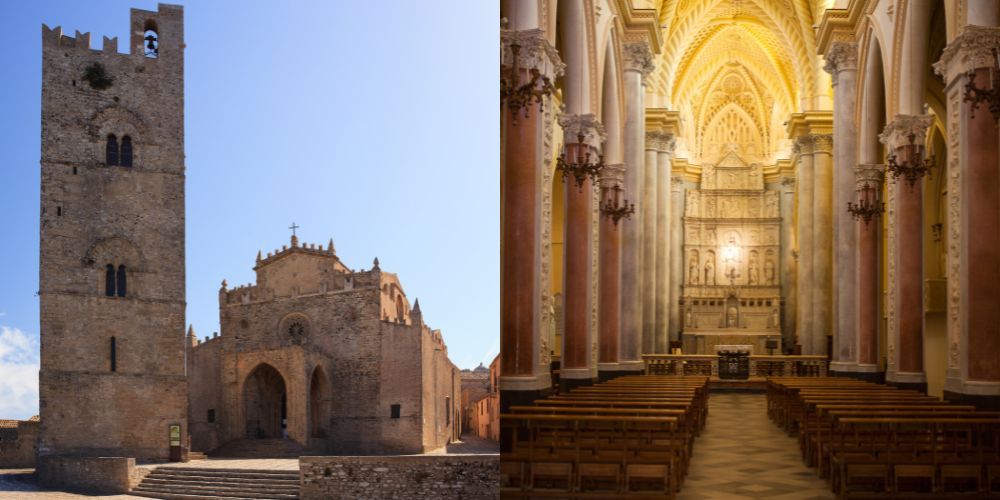
This church, dedicated to the Assumption of Mary, is the most important place of worship in Erice and is better known as the Real Duomo or Madrice di Erice. Its location is near Porta Trapani, in the south-west area of the village, near the funicular station at the top of the mountain.
La Madrice was built in Gothic style in the early 14th century on a pre-existing chapel dedicated to the Virgin Mary, dating back to the advent of Christianity in western Sicily and the consequent decline of the cult of Venus. However, most of the materials used for the construction of the Cathedral came exactly from the ancient temple of the Goddess.
Frederick III of Aragon, governor in this part of Sicily in that age, commissioned the construction of the Madrice during his temporary residence in Erice on the occasion of the events of the War of the Sicilian Vespers. The large quadrangular bell tower of the church, also called King Frederick's Tower, is dedicated to the sovereign.
Over the centuries, the church has been restored several times and embellished with very valuable pieces of sacred art; it is no coincidence that in one of the most important internal chapels of the Madrice is now kept the so-called Treasure of Erice, consisting especially in ancient and precious golden and silver artifacts.
Ettore Majorana Foundation and Centre for Scientific Culture
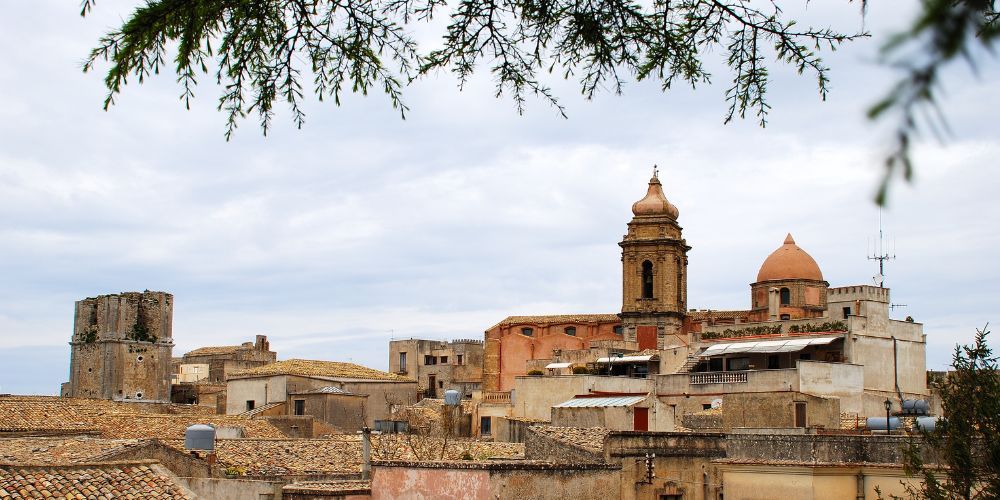
Last but not least, a stage that has made Erice famous in the world not only as a tourist pearl and a place of immense culture, but also as a relevant meeting point of scientific thought: it is the Centre for Scientific Culture dedicated to Ettore Majorana.
The centre was founded in 1963 by the trapanese physicist Antonino Zichichi, within ancient premises previously occupied by religious communities, and every year it hosts events and welcomes international scientists to discuss the main problems of our world in this beautiful landscape setting. The centre includes the collaboration of more than one hundred post-university scientific schools and also deals with the provision of special scholarships for the most deserving students and researchers.
Also called "the university of the third millennium" thanks to its most characteristic qualities, that are multidisciplinarity and constant openness to dialogue even between scientific and humanistic studies, since 1988 the centre has also organized the Prize of Science for Peace, which is dedicated precisely to this peaceful and productive union between all disciplines.
Erice, the "Mount". The centuries here have given appointment to Gods and demi-Gods, to heroes and water lilies, to saints and hermits, to faith and art. And they have met and still live there admirably, after wars, splendor and misery, when the view, from the top of the Mount, extends towards blue horizons and moves, fertilized by ancient memories, to unknown dimensions pregnant with infinity to reach timeless Erice.
What to see near Erice: the Salt Way Road
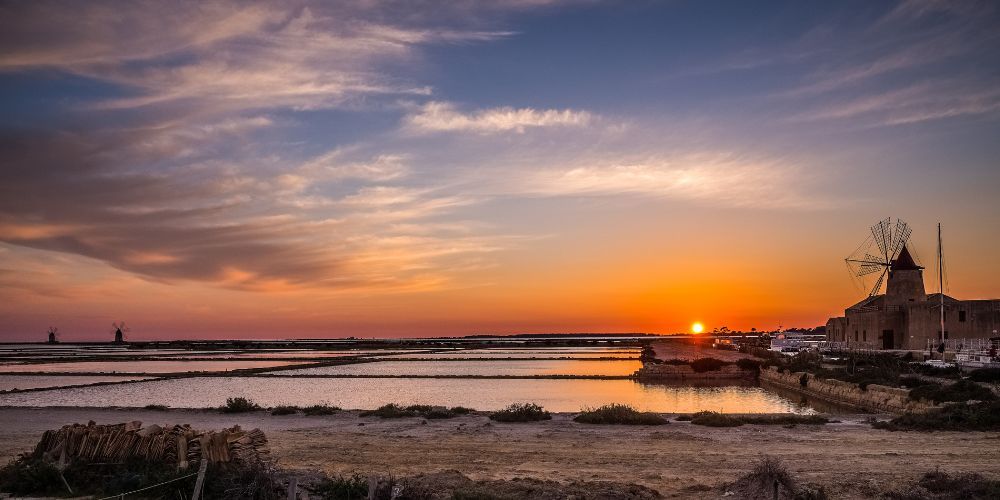
What a view Erice! And how much history, how much culture, how much beauty runs through its alleys, enhancing even more an exceptional land like western Sicily.
Are you looking for other beautiful experiences to enrich your trip to Trapani and its surroundings? Then you absolutely must visit the Salt Way Road, one of the most incredible coastlines in Italy which for about 25 km connects the provincial capital to the splendid city of Marsala, a true paradise to discover admiring the wonder of the mills and salt pans that passionately meet the warm sunlight.
To best complete your trip, visit one of the most prestigious wineries in the area and try many varieties of local wines accompanied by the specialties of Sicilian cuisine, from savory to sweet, a true meeting of exceptional flavors with which explore this wonderful island through taste.
Find out how to taste the best wines of MarsalaAbout the author
Written on 28/02/2024



Eleonora Monaco
Check out what to see in Erice, the mythical city of Venus in Sicily. Here are for you 5 iconic places to visit and fantastic experiences to enjoy!